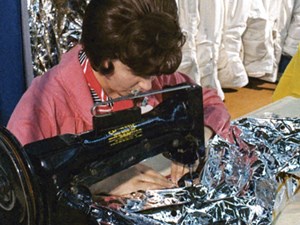What's new in exploration
where I resolved to become an explorationist. My peers in physics class mocked me, until that year Star Trek was nominated for an Emmy. I was further vindicated just two years later, when on July 20, 1969, over 650 million earth-bound humans watched TV as three men boldly flew to the earth’s moon, and a mere man stepped on its surface, fully knowing he would not be swallowed up by quicksand or meet any alternate-sexed metal aliens. All three men were wearing handmade spacesuits carefully stitched by a few un-sung women of Ohio, Fig. 1. The TV show Star Trek failed that year after the world saw science and fiction crossing paths on topic, and electrifying imaginations way beyond H.G. Wells’ writings.

Humans would no longer accept faky stage sets with tiny spaceships held by a string. Fifty years later, exploration in space is still very alive. Buzz Aldrin is correct when he stated last month that the moon landing, the first by Apollo 11, proved the “can-do” spirit of America. Seeing what is happening today commercially, and from other countries, there remains a lot of “can-do” in humans, at least in getting and staying in outer space.
Hydrocarbon use has deep roots. So, will “can-do” exploration for oil and gas have another big anniversary? Some say a guy named Herodotus used oil-based asphalt to help build the tower of Babylon, over 4,000 years ago. Herodotus did not tell who discovered the natural seep he used, but like today, the production engineers get the credit. Not to be outdone, China claims that the earliest known oil wells, meaning the first oil wells were drilled by them, were in that country around 347 AD. Of course, they were unaware of any time scale using AD, and their bamboo “pipe” was novel, possibly the beginning design of Chinese-made casing.
However, history names a Scot, Jim Young, as the catalyst to start the modern O&G business. Young distilled light oil for lamps while obtaining lube oil products, on or about 1847. I would absolutely say that a Scot should get credit for being the first at distilling about anything found naturally on this planet. Sorry Drake and Pennsylvania, but, it was the Americans who broke forth the great oil boom shortly after that.
Groundbreaking navigation work. I would be remiss to not mention two explorers that made a dramatic change to seismic marine exploration and changes to worldwide navigation specifically. In late 1984, Marathon was shooting 2D seismic in the mouth of the Amazon. Navigation accuracy was terrible, due to notorious radio nav interference from the Brazilian Shield. Shooting in the river was bad enough, where the seismic cable tail buoy more than once passed the front of the boat when recording downstream. While I was working with Roland Marchall of Prakla-Seismos to create a process to decipher the CDP’s from a very crooked line, Jeff Sposato and Chris Appleyard were experimenting with GPS to control positioning of the boat to stay on the pre-determined track.
No one at service wanted to trust the new system, so a plotter was placed in the wheelhouse of the Solea while the helmsman steered using expensive, but not very real-time radio signal. We had to maintain three to four manned radio stations in remote locations for over three months at great headache. Post-mission, the GPS had correctly described the [months later] regression trend analysis of the radio nav. Meaning, better to know where you are rather than know where you have been.
The next year, Teledyne agreed to actually real-time steer the new 2D program, using an upgraded system that Jeff and Chris built. It worked. Radio nav was the backup. Marathon did not want a patent for the new method, maybe because we also found that our actively drilling jackup, way offshore northeastern Brazil, was more than a mile off from the 1982 seismic data [radio nav-derived]. Teledyne requested, then adapted GPS nav, as Jeff designed it, to fit all its ships. Chris went off to help find the Challenger, and the rest is history.
Pioneering spirit missing from today’s industry. Sadly, today not many “boldly” go anywhere in this business. Most of the boldness was actually performed in the 1950s. Risk-takers like them are rarer today, not all because there are not people willing to take risks. It seems obvious to more and more banks, and some investors, but not the shale players, that producing where you pay your buyer is neither exploration or good business.
With great disappointment, Weatherford filed for Chapter 11 bankruptcy [7/3/2019]. They intend to come back asap. When they do, they should not only help lower production expense, but some of their tool sets make for affordable methods of collecting usable exploration data.
The Society of Exploration Geophysicists’ annual convention is in San Antonio, September 15-20. This year’s expo has a well-rounded line-up of technical presentations and interesting topics. The society is also sponsoring several SEG summer camps for college students. This convention is worth attending. WO



